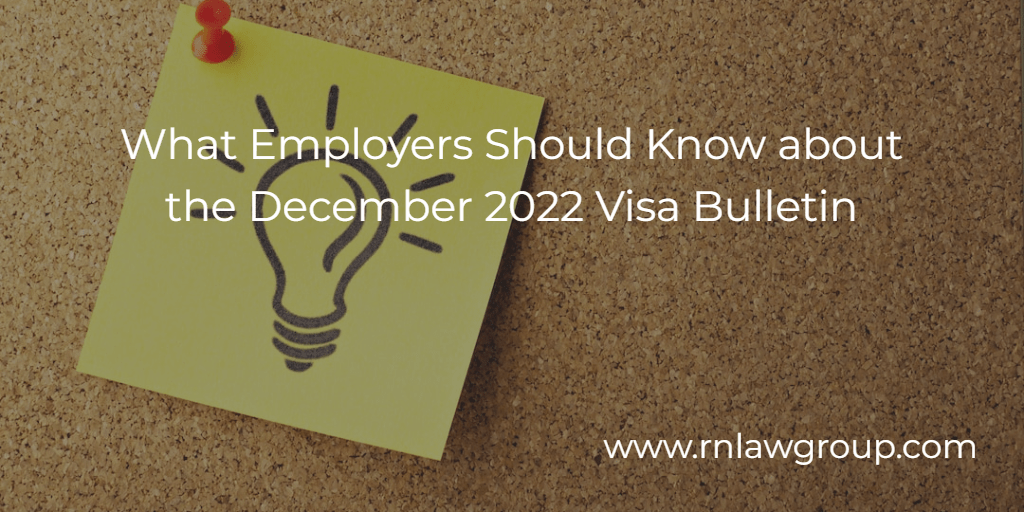
What Employers Should Know about the December 2022 Visa Bulletin
The employment-based permanent residence process, commonly referred to as the green card process, is dependent upon the availability of immigrant visas (or green cards) based on the sponsored worker’s country of birth and category. Every month, the Visa Bulletin summarizes the availability of these green cards according to country of birth and category in order for workers to file the final step of the process, the Adjustment of Status if in the United States, or Immigrant Visa processing at a U.S. consulate or embassy outside the country. In an unusual step, the December Visa Bulletin published by the U.S. Department of State institutes a cut-off date for the EB-2 category for ROW and issues a warning that it may be necessary to implement a cut-off date in the EB-1 category for workers from India or China.
Why is this important?
When immigrant visas are available, sponsored workers can complete the final steps of the process to receive their green cards. When a cut-off date is instituted, immigrant visas are unavailable, and sponsored workers must wait to file the remaining step, or if already filed, cannot receive the approval.
For workers born in countries other than India or China, immigrant visas are normally available in the most common categories of EB-1, EB-2, and EB-3. For workers born in India or China, immigrant visas are normally available in the EB-1 category, but there is a waiting list for the EB-2 and EB-3 categories, which can last several years. This is commonly referred to as the visa backlog. Workers in the United States from India or China who have been sponsored in the EB-2 or EB-3 category must continue to maintain their temporary work visas through continued renewal petitions filed with the immigration service. Workers from other countries (commonly referred to as Rest of World, or ROW) and those in the EB-1 category, are able to file the final steps of the process much earlier and often do not need multiple renewals of their temporary work visas. With the December Visa Bulletin, this may change.
What does this mean?
As the December Visa Bulletin institutes a cut-off date for the EB-2 category for ROW, it is expected that a cut-off date will continue to remain in place for these workers for the remainder of the fiscal year (through September 30, 2023) due to higher than usual demand in this category. This means that workers, who could normally file their I-140 immigrant petition and I-485 adjustment of status applications together (concurrently) as soon as their labor certification (PERM) has been approved, must now wait until an immigrant visa becomes available for them based on the date the labor certification was filed on their behalf. This may require a renewal of their temporary work visas, which normally would not have been needed. In some cases, it may require a worker to change status to another visa category in order to continue to be authorized to work while waiting.
For example, it has been possible for an employer to complete the entire employment-based green card process (PERM, I-140, Adjustment of Status) for a worker who is not from India or China while the worker was employed based on their F-1 Optional Practical Training. This program provides up to 3 years of work authorization for international students after graduation with a STEM degree. This may no longer be possible as the OPT time may run out before the worker is able to file for Adjustment of Status and receive a work permit (EAD). An employer may now need to consider sponsoring the worker for an H-1B visa, which in most cases requires the employer to submit a registration on behalf of the worker in a lottery and the registration must be selected in the lottery in order to proceed.
Another example could be in the case of an L-1B visa holder. The L-1B visa can typically only be extended for a total of 5 years. For workers not from India or China, it was often possible for an employer to complete the PERM-based green card process by the end of the 5 years. But, with a cut-off date implemented for EB-2, it may necessary to start the process earlier or plan to change the worker to another visa category so that employment authorization can continue.
What can employers do?
It should be noted that the cut-off date implemented for ROW in EB-2 in the December Visa Bulletin has not been implemented in the EB-3 category. This provides an opportunity to overcome some of the challenges described above. If a worker from ROW has a labor certification that is valid for the EB-2 category, the company can instead file the I-140 petition in the EB-3 category where immigrant visa numbers remain available for ROW. This would then allow the Adjustment of Status application to be filed concurrently and the green card to potentially be received faster than the EB-2 category.
Another point to be aware of in the December Visa Bulletin is a warning that it may be necessary to implement a cut-off date in the EB-1 category for workers from India or China due to increased demand. This could impact multinational managers or executives from India or China who could normally complete the entire non-PERM based green card process (I-140 and Adjustment of Status) before their L-1A 7 year limit was reached. Once a cut-off date is implemented for EB-1 India and China, it may be necessary to begin the green card process earlier than usual for those in L-1A status as they may have to wait to be eligible to file the final step, the Adjustment of Status. If the process is not started early enough, the worker may run out of employment authorization or have to convert to a different visa category.
Emily Neumann is Managing Partner at Reddy Neumann Brown PC with over 15 years of experience practicing US immigration law providing services to U.S. businesses and multinational corporations. Emily has helped transform the firm from a solo practice to Houston’s largest immigration law firm focused exclusively on U.S. employment-based immigration. She received her Bachelor’s degree in Biology from Central Michigan University and her Juris Doctorate degree from the University of Houston Law Center. Emily has been quoted in Bloomberg Law, U.S. News & World Report, Inside Higher Ed, and The Times of India on various hot topics in immigration. She is a member of the American Immigration Lawyers Association and Society for Human Resource Management.

